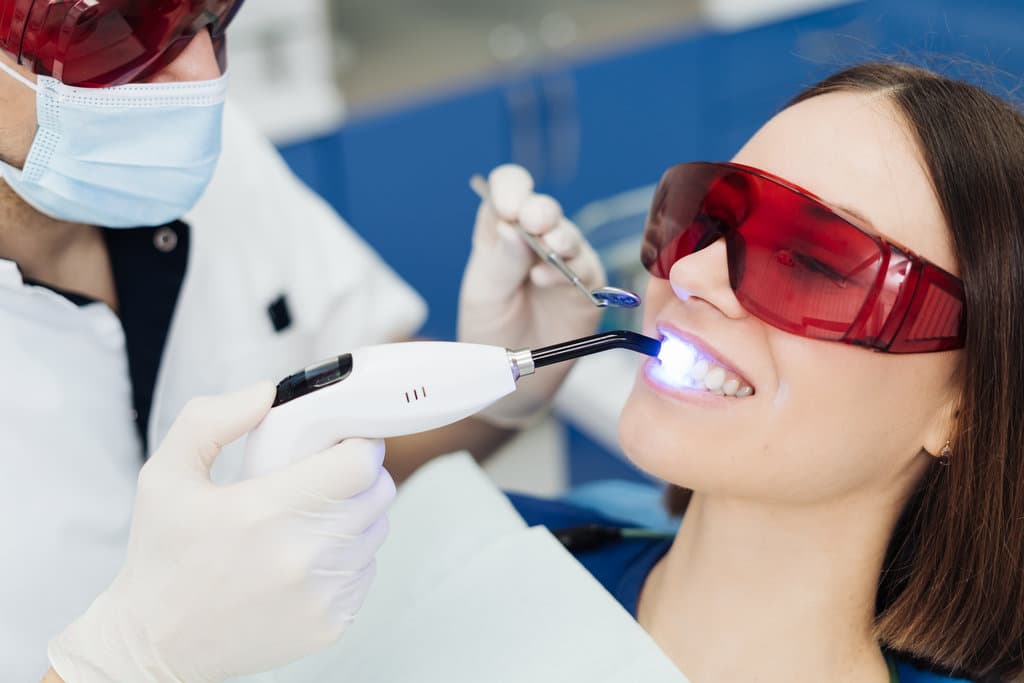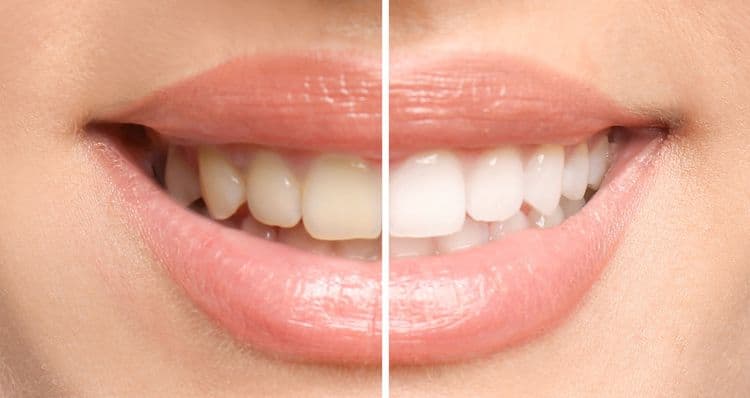Professional teeth whitening can last from several months to a year, with some individuals maintaining results for up to three years through proper care. Longevity is influenced by treatment type, lifestyle, and oral hygiene. In-office whitening, using stronger bleaching agents, offers longer-lasting effects compared to at-home methods. Regular touch-ups may be necessary, especially for those frequently exposed to stain-causing substances. Understanding these factors is essential for anyone considering this cosmetic procedure.
Understanding Professional Teeth Whitening Options
When considering the array of professional teeth whitening options available, it is crucial to understand the underlying mechanisms and efficacy of each method. Laser whitening utilizes concentrated light to accelerate the bleaching process, enhancing the effectiveness of bleaching gels. These gels typically contain hydrogen peroxide or carbamide peroxide, which break down stains on the enamel. Whitening trays, custom-fitted by dental professionals, guarantee even application of the gel, maximizing contact with the teeth. Each method requires a professional assessment to determine suitability based on individual dental health and desired outcomes. Clinical studies indicate a high efficacy rate for professionally administered treatments, as they offer controlled conditions and higher concentrations of active ingredients compared to over-the-counter alternatives, guaranteeing ideal results and patient safety.
Factors Affecting Whitening Longevity
Selection of a professional teeth whitening method greatly impacts the duration of its effects. Clinical evidence suggests that in-office treatments tend to yield longer-lasting results compared to at-home options. The longevity of whitening is also influenced by the whitening frequency; frequent treatments can maintain brightness over time, though they must be balanced against the potential for enamel sensitivity. In addition, lifestyle choices play a critical role. Individuals who smoke or consume staining beverages like coffee or red wine may experience diminished whitening effects more rapidly. Evidence-based studies highlight that non-smokers and those who limit exposure to staining agents typically enjoy prolonged results. Consequently, the interplay between the chosen whitening method, frequency, and lifestyle decisions critically determines how long professional whitening effects endure.
The Role of Diet in Maintaining White Teeth
A balanced diet plays a pivotal role in maintaining white teeth post-whitening treatment. Dietary choices greatly influence the longevity of whitening results. Consuming stain causing foods such as berries, tomato sauce, and soy sauce can compromise the brightness of teeth. Additionally, beverage effects are substantial; drinks like coffee, tea, and red wine are notorious for staining due to their chromogen content. Furthermore, acidic substances such as citrus fruits and vinegar can erode enamel, making teeth more susceptible to discoloration. Evidence suggests that moderating intake of these items and choosing alternatives like water and milk can help preserve whiteness. As a result, individuals should consider their dietary habits to prolong the effects of professional teeth whitening effectively.
Impact of Oral Hygiene on Whitening Results
The longevity of teeth whitening results is markedly influenced by rigorous oral hygiene practices, with daily brushing being paramount in removing surface stains and preventing plaque buildup. Evidence suggests that consistent flossing is essential for reaching areas between teeth that brushing misses, thereby aiding in maintaining the brightness achieved through whitening treatments. Additionally, using an appropriate mouthwash can extend the effects of whitening by eliminating bacteria and reducing the risk of discoloration.
Daily Brushing Importance
Maintaining ideal oral hygiene, particularly through daily brushing, greatly influences the longevity of teeth whitening results. Research indicates that consistent brushing frequency, at least twice daily, removes surface stains and plaque that can diminish whitening effects. Effective daily brushing techniques involve using a soft-bristled toothbrush and fluoride toothpaste, ensuring to cover all tooth surfaces. This practice not only aids in preserving the whiteness but also promotes overall oral health. Neglecting proper brushing can lead to a build-up of extrinsic stains, quickly altering the tooth’s newly whitened appearance. Studies have shown that individuals adhering to these guidelines experience prolonged whitening benefits compared to those with inadequate oral care routines. Consequently, daily brushing plays a pivotal role in maintaining the aesthetic results of professional teeth whitening.
Flossing and Whitening Maintenance
Incorporating regular flossing into one’s oral hygiene routine can considerably enhance the longevity of teeth whitening results. Flossing techniques effectively remove plaque and food particles in areas a toothbrush might miss, preventing discoloration and maintaining the effects of whitening products. Clinical studies suggest that individuals who floss daily preserve their whitening outcomes longer than those who do not. By disrupting the biofilm that forms between teeth, flossing reduces the accumulation of stains that may compromise the desired brightness post-whitening treatment. The meticulous removal of debris through proper flossing techniques guarantees that whitening products penetrate more uniformly, optimizing their efficacy. Consequently, consistent flossing is a critical adjunct to professional teeth whitening, sustaining the aesthetic benefits through enhanced oral cleanliness.
Mouthwash’s Role in Longevity
While flossing plays an important role in preserving teeth whitening results, mouthwash also contributes considerably to oral hygiene and the longevity of whitening effects. The inclusion of specific mouthwash ingredients, such as hydrogen peroxide and sodium hexametaphosphate, aids in maintaining whitening effectiveness by reducing surface stains and preventing new discolorations. Clinical studies indicate that using mouthwash formulated with these active ingredients can enhance whitening results by providing a barrier against stain-causing agents like coffee and tobacco. Additionally, antiseptic mouthwashes containing chlorhexidine or cetylpyridinium chloride reduce oral bacteria, contributing to overall gum health and indirectly supporting whitening longevity. Regular use of such mouthwashes, alongside brushing and flossing, can sustain the brightness achieved from professional whitening treatments, thereby prolonging the aesthetic benefits.
Genetic Influences on Tooth Color Retention
Genetic factors play a significant role in tooth color retention, particularly through inherited staining tendencies and variations in enamel thickness. Studies have shown that individuals with naturally thinner enamel are more susceptible to discoloration, as the underlying dentin’s color can influence the tooth’s appearance. Additionally, genetic predispositions may affect the rate at which extrinsic stains adhere to the enamel, impacting the longevity of whitening treatments.
Inherited Staining Tendencies
Understanding the impact of inherited staining tendencies is essential in evaluating the longevity of teeth whitening results. Genetic predisposition plays a significant role in determining how long whitening effects endure. Individuals with a genetic predisposition to specific staining types, such as intrinsic or extrinsic discoloration, may experience varied outcomes post-whitening. Intrinsic stains, often linked to developmental factors, can be deeply embedded within the tooth structure, making them more challenging to address effectively. Conversely, extrinsic stains, typically a result of environmental factors, may be more responsive to whitening interventions. Research indicates that genetic factors influencing enamel porosity and tooth composition critically affect stain retention. This variability underscores the necessity for personalized treatment plans, taking into account each individual’s genetic background for effective whitening longevity.
Enamel Thickness Variations
Enamel thickness, a genetically influenced trait, greatly impacts tooth color retention and the effectiveness of whitening treatments. Thicker enamel generally offers more robust protection against discoloration, as it provides a denser barrier over the underlying dentin, which is naturally yellower. Thin enamel may allow more of the dentin’s color to show through, potentially diminishing the perceived efficacy of whitening procedures. Studies suggest that whitening durability is markedly influenced by enamel’s resilience to wear and staining agents. Individuals with thicker enamel often experience longer-lasting results from professional whitening treatments, as their enamel resists re-staining more effectively. Variations in enamel thickness highlight the need for personalized approaches in cosmetic dentistry, ensuring favorable outcomes based on individual genetic predispositions.

Comparing In-Office Whitening to At-Home Treatments
When considering the longevity and effectiveness of teeth whitening, how do in-office treatments compare to at-home options? In-office whitening offers significant benefits, particularly its potent bleaching agents and professional application, which can result in immediate and longer-lasting results. The procedure typically uses a high concentration of hydrogen peroxide, enhanced by light or laser activation, providing rapid and uniform whitening. In contrast, at-home treatments boast convenience and ease of use. These include custom-fitted trays or over-the-counter products with lower peroxide concentrations. While more accessible, at-home methods may require consistent application over several weeks to achieve noticeable results. Studies indicate that in-office treatments can last up to a year or more, whereas at-home results typically require maintenance every few months.
Tips for Prolonging Your Whitening Results
To maximize the longevity of teeth whitening results, specific post-treatment care strategies play an essential role. Evidence-based guidelines suggest that patients should avoid stain-inducing foods and beverages, such as coffee, red wine, and berries, particularly in the initial 48 hours post-treatment. Lifestyle changes, including the cessation of smoking, can greatly prevent discoloration. Home remedies, like rinsing with baking soda or oil pulling, may offer adjunctive benefits in maintaining results. Additionally, using a whitening toothpaste or mouthwash can aid in sustaining enamel brightness. Clinical studies affirm that maintaining excellent oral hygiene through regular brushing and flossing is vital. These interventions collectively support prolonged whitening effects, minimizing the need for frequent professional touch-ups while ensuring ideal dental health.
Recognizing When It’s Time for a Touch-Up
Determining the appropriate time for a teeth whitening touch-up can greatly impact the longevity of the treatment’s effects. Clinicians recommend monitoring for specific touch up signs, which include noticeable yellowing, staining from beverages such as coffee or wine, and diminished brightness. These indicators suggest that the whitening agents have worn off, necessitating a timely intervention to restore the desired shade. Establishing a personalized whitening schedule is essential, as individual lifestyle factors and oral hygiene habits greatly influence the retention of whitening results. Evidence suggests that a touch-up every six to twelve months may be sufficient for most individuals, although those with higher exposure to staining agents might require more frequent maintenance. Regular dental assessments can assist in determining ideal timing.
Cost Considerations and Value of Long-Term Results
Understanding the timing for a teeth whitening touch-up naturally leads to reflections on cost and the value of maintaining long-term results. A thorough cost analysis reveals that professional teeth whitening, though initially more expensive than at-home alternatives, offers superior longevity and effectiveness, reducing the frequency of needed touch-ups. This positions professional whitening as a long-term investment in oral aesthetics. Evidence suggests that with proper maintenance, results can last up to three years, diminishing the need for frequent re-treatment. The cost efficiency, when evaluated over extended periods, is evident in the reduced cumulative expenses and sustained aesthetic satisfaction. Consequently, the initial cost is often justified by the enduring brightness and overall oral health benefits derived from professional whitening treatments.
Frequently Asked Questions
Is Professional Teeth Whitening Safe for Sensitive Teeth?
Professional teeth whitening can be safe for sensitive teeth with proper sensitivity management. Dentists may recommend whitening alternatives like lower concentration gels or desensitizing agents, supported by evidence-based practices to minimize discomfort while achieving desired results.
Can Teeth Whitening Cause Permanent Damage to Enamel?
Teeth whitening typically does not cause permanent damage to teeth enamel when performed professionally. Whitening effects are achieved through controlled chemical processes, ensuring enamel integrity. Evidence-based research supports its safety, provided guidelines and precautions are strictly followed.
How Soon After Whitening Can I Consume Coffee or Red Wine?
After teeth whitening, it is recommended to avoid dark beverages like coffee or red wine for at least 48 hours. These whitening precautions guarantee ideal results and prevent staining, allowing the treatment to maintain its effectiveness.
Are There Any Age Restrictions for Professional Teeth Whitening?
Professional teeth whitening typically has no strict age restrictions, but age recommendations suggest eligibility generally starts at 16. This is due to the maturity of dental structures, ensuring safety and effectiveness as evidenced by clinical studies.
What Should I Do if Whitening Causes Gum Irritation?
If whitening causes gum irritation, it is advised to pause treatment and consult a dental professional. They may suggest gum care strategies or whitening alternatives, ensuring an evidence-based approach addressing sensitivity while maintaining oral health.


